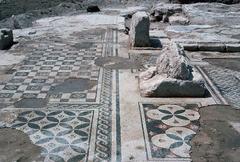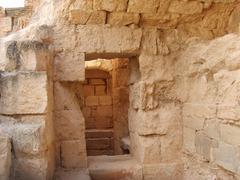Yarmouk Forest Reserve - Visiting Hours, Tickets, and Historical Sites in Irbid, Jordan
Date: 18/07/2024
Introduction
Nestled in the northwestern hills of Jordan, the Yarmouk Forest Reserve is a sanctuary that offers both natural beauty and a rich historical tapestry. Located in the region of Irbid, this reserve is more than just a retreat into nature; it is a gateway to understanding the ancient civilizations that once thrived along the Yarmouk River. The area has been inhabited since prehistoric times, showcasing evidence from Neolithic settlements to Bronze and Iron Age communities (Britannica). The influence of the Roman Empire is still visible through archaeological sites such as Gadara (Umm Qais) and Pella, both part of the Decapolis, a group of ten Roman cities known for their Hellenistic-Roman culture and architecture (UNESCO). Managed by the Royal Society for the Conservation of Nature (RSCN), the Yarmouk Forest Reserve is dedicated to preserving its unique ecosystems and cultural heritage, ensuring that future generations can continue to learn from and appreciate this remarkable blend of nature and history.
Table of Contents
- Introduction
- Historical and Cultural Significance
- Visitor Information
- Exploring the Natural Wonders
- Conservation Efforts
- FAQ
- Conclusion
Historical and Cultural Significance
Echoes of Ancient Civilizations
Yarmouk Forest Reserve sits within an area that has witnessed the rise and fall of empires for millennia. The region surrounding the Yarmouk River, which flows through the reserve, has been inhabited since prehistoric times:
- Neolithic settlements - Indicating early human presence and the development of agriculture.
- Bronze and Iron Age communities - Demonstrating the growth of more complex societies and technologies.
Roman Influence and the Decapolis
The Roman Empire’s reach extended to this region, leaving an indelible mark on its landscape and culture. The Yarmouk River valley became part of the Roman province of Arabia Petraea, and several Roman cities flourished in the surrounding area:
- Gadara (Umm Qais) - Known for its well-preserved Roman ruins, including a theater, baths, and colonnaded streets (UNESCO).
- Pella (Tabaqat Fahil) - An important commercial center with impressive archaeological remains (Britannica).
These cities were part of the Decapolis, a group of ten Roman cities renowned for their Hellenistic-Roman culture and architecture.
Byzantine Era and the Rise of Christianity
Following the Roman Empire’s division, the Yarmouk River valley became part of the Byzantine Empire. Christianity spread throughout the region, and churches and monasteries were built. The area’s strategic location near the Byzantine-Sasanian frontier led to the construction of numerous fortifications, including:
- Qasr al-Hallabat - A former Roman fort later converted into an Umayyad palace (Visit Jordan).
The Battle of Yarmouk
In 636 AD, the Yarmouk River valley witnessed one of the most decisive battles in history – the Battle of Yarmouk. This pivotal conflict pitted the forces of the nascent Muslim Arab army against the Byzantine Empire. The Muslim army’s victory marked a turning point, leading to:
- Decline of Byzantine rule in the Levant.
- Rapid expansion of the early Islamic Caliphate.
Islamic Rule and Cultural Transformation
Following the Muslim conquest, the Yarmouk River valley became part of the Islamic world. The region witnessed the establishment of new settlements and the spread of Islamic culture and the Arabic language. The Umayyad Caliphate, centered in Damascus, left its mark on the area with architectural gems like:
- Qasr Amra - A desert castle known for its well-preserved frescoes depicting scenes of courtly life and leisure (UNESCO).
Ottoman Era and Beyond
The Yarmouk River valley later came under Ottoman rule, becoming part of the wider Ottoman province of Syria. During this period, the region remained primarily agricultural, with local communities relying on the Yarmouk River for irrigation. The Ottoman Empire’s collapse in the early 20th century led to the region becoming part of modern-day Jordan.
Visitor Information
Visiting Hours
The Yarmouk Forest Reserve is open to visitors year-round. Typical visiting hours are from 8:00 AM to 6:00 PM, but it is advisable to check the official website or contact local authorities for the most up-to-date information.
Tickets and Entry Fees
Entry fees vary depending on the season and the visitor’s nationality. For the latest ticket prices, please refer to the reserve’s official website or contact the visitor center directly.
Travel Tips
- Best Time to Visit - Spring and autumn offer the most pleasant weather for exploring the reserve.
- Guided Tours - Available upon request, providing in-depth knowledge about the reserve’s natural and historical significance.
- Nearby Attractions - Consider visiting Umm Qais and Pella, both rich in archaeological treasures, to complement your trip.
- Accessibility - The reserve offers accessible paths for visitors with mobility challenges. However, it’s best to confirm specific facilities in advance.
Exploring the Natural Wonders
Flora and Fauna
The reserve boasts a rich tapestry of flora, with over 300 documented plant species. Visitors can wander through dense forests of Aleppo pine, evergreen oak, and Palestinian pistachio. Spring transforms the landscape into a vibrant canvas, with colorful blooms painting the hillsides.
Yarmouk Forest Reserve is equally renowned for its diverse fauna. Birdwatchers can delight in spotting a variety of resident and migratory birds, including the Syrian woodpecker and the majestic short-toed eagle. The reserve also provides refuge to mammals like wild boar, red fox, and the elusive golden jackal.
Hiking Trails
Yarmouk Forest Reserve offers a network of well-maintained hiking trails, catering to all levels of experience:
- The Wadi al-Yabis Trail - A moderate 3-kilometer trail following the Yarmouk River, leading hikers through lush valleys and past ancient watermills.
- The Tal Mar Elias Trail - A challenging 7-kilometer trail ascending to the summit of Tal Mar Elias, offering panoramic views and the ruins of a Byzantine monastery.
- The Umm Qais Trail - A scenic 5-kilometer trail connecting the reserve to the nearby archaeological site of Umm Qais.
Points of Interest
- The Yarmouk River - Flowing along the reserve’s northern border, the river is a significant historical and geographical landmark.
- The Byzantine Ruins - Scattered throughout the reserve are remnants of Byzantine-era settlements.
- The Observation Tower - Provides breathtaking panoramic views of the surrounding landscapes.
Conservation Efforts
Yarmouk Forest Reserve stands as a testament to Jordan’s commitment to environmental conservation. Managed by the Royal Society for the Conservation of Nature (RSCN), efforts include:
- Reforestation Programs - Initiatives to restore degraded areas and enhance ecological integrity.
- Wildlife Monitoring - Programs that track populations of key species.
- Community Engagement - Promoting sustainable practices and raising awareness about the importance of conservation.
FAQ
Q: What are the visiting hours for Yarmouk Forest Reserve? A: The reserve is typically open from 8:00 AM to 6:00 PM. However, it is advisable to check the official website for the most current information.
Q: How much are tickets for Yarmouk Forest Reserve? A: Ticket prices vary depending on the season and the visitor’s nationality. For the latest information, please refer to the reserve’s official website or contact the visitor center.
Q: Are there guided tours available? A: Yes, guided tours can be arranged through the Royal Society for the Conservation of Nature (RSCN). Contact their office for more details and booking information.
Q: Can we camp inside the reserve? A: Camping is not permitted inside the reserve, but there are nearby campsites that offer outdoor accommodations.
Q: Are there any special events held at the reserve? A: The RSCN occasionally organizes special events and educational programs. Check their website or contact their office for the latest updates.
Q: What are the best photographic spots in the reserve? A: Popular spots include the observation tower, the Yarmouk River, and the summit of Tal Mar Elias.
Conclusion
The Yarmouk Forest Reserve stands as a testament to Jordan’s rich history and cultural heritage. By preserving its diverse ecosystems, the reserve ensures that future generations can continue to learn from and appreciate its historical and cultural tapestry. Plan your visit today to explore this remarkable blend of natural beauty and historical significance.
References
- Exploring the Yarmouk Forest Reserve - History, Significance, and Visitor Information. UNESCO, 2024, UNESCO
- Exploring the Yarmouk Forest Reserve - History, Significance, and Visitor Information. Britannica, 2024, Britannica
- Exploring the Yarmouk Forest Reserve - History, Significance, and Visitor Information. Visit Jordan, 2024, Visit Jordan


